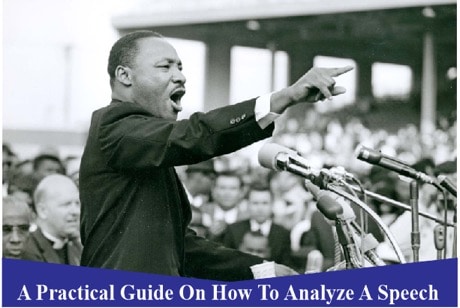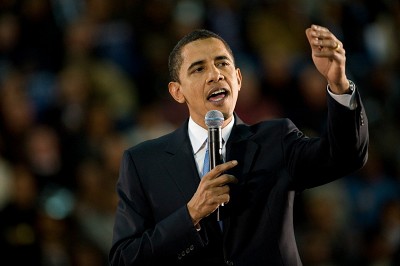5 Speeches Considered Best in History: A lesson to Communicators
A great speech remains in the minds of those who listen to it and can make history. No matter how much time passes, some lines are eternalized – for different reasons. The ones highlighted in this article were no different. Times Magazine is known for its “Best of All Time” lists of best movies, music, and books…
Some time ago, the magazine chose the ten speeches it considers the best in history: from Socrates to Churchill, Reagan to Luther King, and so many other names. But what makes these speeches appear on this list? And what can we communicators learn from each of them? This article will analyze some of the addresses listed in the Times Magazine and find out what made them so impactful.
-

11 Best Body Language Tips For Engaging Presentations (#11 is Underrated)
-

A 9-Step Practical Guide On How To Analyze A Speech – Speech Analysis of I have A Dream Speech as an Example
-

An Easy Guide to All 15 Types of Speech
5 Speeches Considered Best in History: A lesson to Communicators
1. Nelson Mandela‘s 1994 Inauguration Speech
A. Repetition
Repetition is one of the hallmarks of Mandela’s oratory. This feature fulfills a variety of roles, such as:
- Highlight an idea;
- Organize reasoning;
- Increase emotionality in a particular stretch.
While it is true that, in writing, repetition can be a problem, in spoken language, it is essential. In his inaugural speech as president, Mandela used repetition in several passages:
“May there be justice for all. May there be peace for all. May there be work, bread, water, and salt for all”.
Mandela
Like the one above, Repetition reinforces the central ideas of the speech and its argument as a whole.
B. Pauses
Communication is not only made of words but also silences. These silences – or “intentional pauses” – are very important in any speech exposure situation. Knowing how to use them is a way to boost speeches, making them much more organized, emotional, and inspiring.
In his speeches, Mandela adopted a particular way of using silences, naturally and subtly, but powerful at the same time.
Breaks are helpful to:
- Inform the audience that something important is to be said;
- Highlight an idea;
- Increase the degree of emotionality in a specific passage.
Allow time for the audience to assimilate an idea before another is presented. In Mandela’s speeches, pauses are mainly used to emphasize a passage or give emotion to what is being said.
C. The use of “we.”
The choice of words to convey a message is crucial. After all, as important as what you say is how you say it. In his speeches, both the inaugural address in 1994 and the one he gave at Harvard in 1998, Mandela used the first person plural, that is, the “we”:
“We need to constantly remind ourselves that the freedoms that democracies carry are empty shells if not accompanied by real and tangible improvements.”
Mandela
By choosing “we” over “I,” Mandela brings his speech closer to the public, thus creating an empathic relationship between them. Getting close to the audience is a central requirement for an inspiring speech, and Mandela’s speeches are proof of that.
The “we” also serves as an efficient strategy to cause emotion and explain–and highlight – the figure of the communicator as a leader, as someone who thinks and represents something more significant: the collective. This becomes even more explicit in a few passages:
“We know very well that none of us can succeed by acting alone. Therefore, we have to act together, as a united people”.
Mandela
D. Use of voice intonation
The voice is an instrument, the bridge between the communicator and his audience. Knowing how to use this instrument, and getting the best out of it, is a skill familiar to great speakers like Mandela.
When it comes to voice, or rather, vocal expression or intonation, one of Mandela’s hallmarks is the variation in tone of voice. He spontaneously varied his style within the same sentence or paragraph in his speeches.
Varying the tone of voice is a tool to draw and, more than that, retain people’s attention.
Bass and treble tones have different functions linked to the message you want to convey. One way or another, avoiding keeping to the same manner is important in situations of speech exposure.
E. Passion
Speaking like a leader means speaking with passion and standing up for what we truly believe in. Love for his cause contributed significantly to Mandela’s oratory being so inspiring. People might not even agree with his arguments, but the passion with which he spoke was undeniable.
Many believe that speaking with passion is specific to significant historical figures, such as Mandela. The truth is something familiar to good communicators, regardless of their niche or the purpose of their arguments.
The audience notices and feels whether the communicator’s speech is genuine. By feeling that he is, he has more confidence and becomes less resistant to listening to – and even accepting – the arguments that come to him.

2. Steve Jobs
Let’s see, then, what makes Steve Jobs’s oratory a milestone for modern communication:
A. Assertiveness
There are many definitions of assertiveness. However, one of the most accepted is the one that considers the ability to convey information and opinions in the clear, going too far into the subject and without letting any doubts appear. The famous “get straight to the point.”
Assertiveness is an emotional competence typical of great communicators like Jobs. There are many characteristics of Jobs that demonstrate why assertiveness is one of the three pillars of his oratory. Such features range from the choice of content to non-verbal language.
B. Non-verbal language
There are many videos of Steve Jobs’s presentations and speeches. It is not difficult to notice that he has mastered his non-verbal language when watching them. The movement on stage, the gestures, the changes in the tone of voice: everything is harmonized and, most likely, was carefully planned.
Ever stopped to think about what this pocket is for? Now we know because this is the iPod Nano.”
Non-verbal language is part of the unspoken dynamics of every communication process and means, in short, what we communicate beyond words. One of the most classic examples is the presentation of the iPod Nano. Jobs took the tiny (at least for the time) device out of his pocket: a picture worth that.
The use of pauses, like someone looking for the right word to use next, is another hallmark of Jobs’s oratory.
C. Selection of information and choice of data
Jobs’ assertiveness is also in the choice of information he conveys to his audience. If you look closely at one of his speeches, you will see that nothing is left over; everything that is left overused plays a role.
This is much more than getting straight to the point, but rather organizing the content so that it becomes compact and efficient at the same time. How to do this? Well, without a doubt, this high degree of assertiveness is closely linked to prior planning, as we will see below.
D. Simplicity
When we talk about Steve Jobs, many of us immediately think of the image of the man with discreet glasses and dressed in the usual black T-shirt and jeans. And therein lies one of the examples of simplicity that we cite here.
The setting for Jobs’s exhibitions was sober, with few objects beyond the pulpit—or not even the pulpit, in some cases. The simplicity/neutrality of his clothing extended to other aspects of the presentations, such as, for example, the visual part, that is, the use of slides and the backdrop he decided to use. Currently, this model is used in large conferences, such as TEDx.
Slides, in turn, were far from serving as “crutches” for speech: they were a plus, a compliment. It is worth remembering that, in the slides, Jobs used to use images – not texts. This strategy is very effective to this day.
“The simple can be harder to do than the complex; you have to work hard to clear your thinking to make it simple.”
Steve Jobs
As Jobs himself said in the quote above, getting to the simple is a process of communication that requires explicitly polishing the content, that is, selecting data, reviewing speeches, and organizing excerpts.

3. Winston Churchill – We will never Surrender
Churchill is considered by many to be one of the most excellent communicators of all time. One of his speeches appears on the Times list: the “We will never surrender” speech. From this speech, some resources that we can highlight and apply in our addresses are:
A. Pauses
A characteristic of Churchill was, precisely, the use of pauses, so underestimated by many communicators. Listen to an excerpt from his speech and notice how the pauses are well applied and give rhythm and emotion to what is said.
Incidentally, perhaps for today’s times, Churchill’s pace of speech might be considered excessively slow, but it turned out to be a trait of his authenticity in oratory.
B. The use of We
This is one of the differences between Churchill’s speech and the other speeches we will analyze. He chooses to direct his speech to the second person, using the “we .”This way of communicating efficiently creates a connection with the public and, above all, induces a certain CTA: a call to action. In Churchill’s speech, this CTA is relatively straightforward, as you’ll notice by watching the following excerpt.

4. Abraham Lincoln
Lincoln’s speech is one of the most cited to date: in communication analyses, speeches by other politicians, and so many different contexts. It is a short speech, marked mainly by assertiveness.
A. Assertiveness
By the standards of the time, Lincoln’s speech is concise. It is, at the same time, assertive. Everything is said in a direct, clear, and very objective way. This feature is the most striking feature of this speech.
B. Keywords
Like the other speeches we have seen so far, there is the use of repetition. However, in Lincoln’s speech, this repetition occurs with the nation, soil, and people. These words are used in strategic passages and repeatedly appear, which undoubtedly impacted the assertiveness and clarity we discussed in the previous topic.
-

Types of Signposting: 10 Examples of Signposts in Speech
-

The 4 Methods or Types of Speech Delivery
-

The 7 Basic Elements of Public Speaking
5. Barack Obama
A. Pauses
Just like Mandela, pauses are hallmarks of Obama’s communication. In his speeches, presentations, and pronouncements, he often uses “active silences,” strategic pauses between one topic and another.
In communication, intentional pauses can fulfill several functions, such as:
- Increase emotionality in a stretch;
- Highlight an idea;
- Allow the audience to assimilate information before new information is presented;
- Allow the communicator to decide how to proceed with their reasoning.
Obama’s pauses are directly related to self-confidence. He is not “ashamed” to include these silences and, on the contrary, demonstrates, through them, that his speech is meticulously thought out, that everything he says is conscious.
B. Repetitions
Repetition is a technique widely used by great communicators, such as Martin Luther King and, of course, Obama himself:
We can recognize that oppression will always live with us and, even so, fight for justice. We can admit the incorrigibility of poverty and still fight for dignity. We can understand that there will be war and still fight for peace.
Obama
Note, Speaker, that the repetition used by Obama in the excerpt above – and much reapplied in other speeches by the former president – is not just using the same word repeatedly. It repeats an entire structure: “We can recognize… and even then….”
What is the role of repetitions? They:
- Highlight an idea;
- Reinforce an argument;
- Explain the logical sequence used;
- Increase emotional levels;
- Including repetitions in the speeches is, therefore, an efficient strategy in several ways.
C. Logical sequence
Barack Obama’s speeches are known for their accessibility; virtually all audiences can understand them. This accessibility has to do with several factors, ranging from the language used by Obama (which is simple and direct) to the organization of speech.
In other words, Obama’s speeches follow a logical sequence. Whatever the subject addressed and the context in which it finds itself, the content is transmitted in a way in which everything is interconnected. In short, he always tells a story with a beginning, middle and end.
Planning content in advance, arranging it so that it has a logical sequence, is critical – and not just for the President of the United States, but for all people in a situation of speech exposure.
D. Adaptation to the target audience
Another reason why Obama’s speeches are so efficient in their purpose is that the former president dialogues directly with his audience, adapting the content (and even the way of transmitting it) according to the profile of his court hearing.
Knowing, even minimally, the main characteristics of the public is the most effective way to find strategies to dialogue and, above all, to inspire the people who are part of it.
This is an excellent tool for communicators. It is also a way of approaching the audience and creating a relationship of empathy and leadership with them.
E. Expressiveness
Obama’s expressiveness is one of the striking features of his communication. This takes place in a universe where there is still a certain apology for the “mask of neutrality .”That is, politicians and authorities adopt a neutral demeanor in their speeches and public appearances.
Obama is expressive in his gestures: they don’t happen in excess, nor are they shy, but they are in harmony with what is said. He is uninhibited in his smiles and eyes. It is expressive when maintaining eye contact with people in the audience.
It is no wonder that Barack Obama is recognized as one of the foremost communicators of contemporary times. From what we have seen so far, it is clear that he has developed the three pillars of good communication: content, vocal expression, and body expression. More than a politician, Obama communicates like a leader. And this difference is what makes his oratory a landmark and an inspiration for us communicators.
Conclusion
A speech has the power to change the world; different people did all five speeches above and all of them had the same base: purpose, passion, and focus.
Reference and Further Reading
Lessons from Great Communicators
Top 41 Famous Speeches in History by Continent
Barack Obama’s Final Speech: Five Valuable Lessons For Communicators.







